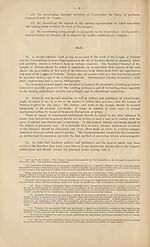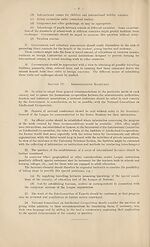Download files
Complete book:
Individual page:
Thumbnail gallery: Grid view | List view

7 —
Section II. — How to develop the Spirit of International Co-operation among
Children, Young People and their Teachers.
“ To regard international co-operation as the normal method of conducting world
affairs ” implies far more than mere instruction in the history and work of the League of
Nations. The form of words adopted by the Assembly at its sixth ordinary session accepts
the principle that co-operation is normal and strife abnormal in the life of civilised mankind
and that in the world of to-day co-operation must be ever more widely extended.
Civilisation in all its principal manifestations is a record of co-operative effort from the
family, the village and the workshop to the vastly more complex institutions of to-day.
To imbue the child with a deep and lasting affection for its family and country remains to-day,
as in former times, the first principle of sound education. But a true patriotism understands
the patriotism of others ; and a recognition of the necessity and omnipresence of co-operation*
both within and without the State, must be emphasised in any education that is to fit young
persons for modern life.
Such instruction cannot be carried out merely as a subject or part of a subject in the
school curriculum. It must permeate all the child’s surroundings. The influence of the
home and the Church is here of enormous importance ; but this subject lies beyond the compe¬
tence of this Committee. For other influences outside the school, one may rely with confidence
on such important organisations as those grouped in the Liaison Committee of the major
international associations which meets at the Institute of Intellectual Co-operation. Our
chief appeal, however, is to the teacher and to those responsible for his training.
The following recommendations indicate merely some practical methods that might be
employed to assist in familiarising both teachers and pupils with the idea of international
co-operation and in encouraging such contact, direct and indirect, as will in turn promote
mutual knowledge and appreciation.
15. The following methods of promoting indirect contact — mainly during school terms
— should be employed where circumstances and the age of the young persons, children or
students concerned render them suitable:
(a) Children’s games, the exhibition of suitable pictures and films, lectures, displays
of foreign handicrafts, visits to historical and artistic museums.
(b) Fetes and pageants, performances of music; in fact, all appeals to the artistic
sense that will encourage a mutual knowledge of different civilisations and peoples.
(c) Inter-school correspondence carried on between classes or other homogeneous
groups, under the supervision of qualified teachers or leaders. This kind of correspon¬
dence might include the exchange of pictures, photographs, postage stamps, examples
of work and, generally speaking, any objects suitable for the purpose.
(d) Association of this inter-school correspondence, where possible, with the work
in school and the exhibition of material thus collected.
(e) Translation of suitable foreign masterpieces, including national folk-tales and
their publication in juvenile periodicals.
(/) Juvenile periodicals. Valuable results might be obtained at a conference where
editors of the more important of these periodicals could discuss the possibilities of
encouraging these contacts.
(g) Studies of different civilisations and the scientific and comparative study of
present-day events.
(h) Any other methods suitable for the various countries, by which solidarity
between children and students of different nations may be outwardly manifested, e.g.,
a badge or certificate of international co-operation.
16. The following methods of encouraging direct contacts between young people would
be valuable :
(«) Interchange of individual children between families.
Section II. — How to develop the Spirit of International Co-operation among
Children, Young People and their Teachers.
“ To regard international co-operation as the normal method of conducting world
affairs ” implies far more than mere instruction in the history and work of the League of
Nations. The form of words adopted by the Assembly at its sixth ordinary session accepts
the principle that co-operation is normal and strife abnormal in the life of civilised mankind
and that in the world of to-day co-operation must be ever more widely extended.
Civilisation in all its principal manifestations is a record of co-operative effort from the
family, the village and the workshop to the vastly more complex institutions of to-day.
To imbue the child with a deep and lasting affection for its family and country remains to-day,
as in former times, the first principle of sound education. But a true patriotism understands
the patriotism of others ; and a recognition of the necessity and omnipresence of co-operation*
both within and without the State, must be emphasised in any education that is to fit young
persons for modern life.
Such instruction cannot be carried out merely as a subject or part of a subject in the
school curriculum. It must permeate all the child’s surroundings. The influence of the
home and the Church is here of enormous importance ; but this subject lies beyond the compe¬
tence of this Committee. For other influences outside the school, one may rely with confidence
on such important organisations as those grouped in the Liaison Committee of the major
international associations which meets at the Institute of Intellectual Co-operation. Our
chief appeal, however, is to the teacher and to those responsible for his training.
The following recommendations indicate merely some practical methods that might be
employed to assist in familiarising both teachers and pupils with the idea of international
co-operation and in encouraging such contact, direct and indirect, as will in turn promote
mutual knowledge and appreciation.
15. The following methods of promoting indirect contact — mainly during school terms
— should be employed where circumstances and the age of the young persons, children or
students concerned render them suitable:
(a) Children’s games, the exhibition of suitable pictures and films, lectures, displays
of foreign handicrafts, visits to historical and artistic museums.
(b) Fetes and pageants, performances of music; in fact, all appeals to the artistic
sense that will encourage a mutual knowledge of different civilisations and peoples.
(c) Inter-school correspondence carried on between classes or other homogeneous
groups, under the supervision of qualified teachers or leaders. This kind of correspon¬
dence might include the exchange of pictures, photographs, postage stamps, examples
of work and, generally speaking, any objects suitable for the purpose.
(d) Association of this inter-school correspondence, where possible, with the work
in school and the exhibition of material thus collected.
(e) Translation of suitable foreign masterpieces, including national folk-tales and
their publication in juvenile periodicals.
(/) Juvenile periodicals. Valuable results might be obtained at a conference where
editors of the more important of these periodicals could discuss the possibilities of
encouraging these contacts.
(g) Studies of different civilisations and the scientific and comparative study of
present-day events.
(h) Any other methods suitable for the various countries, by which solidarity
between children and students of different nations may be outwardly manifested, e.g.,
a badge or certificate of international co-operation.
16. The following methods of encouraging direct contacts between young people would
be valuable :
(«) Interchange of individual children between families.
Set display mode to:
![]() Universal Viewer |
Universal Viewer | ![]() Mirador |
Large image | Transcription
Mirador |
Large image | Transcription
Images and transcriptions on this page, including medium image downloads, may be used under the Creative Commons Attribution 4.0 International Licence unless otherwise stated. ![]()
| League of Nations > International > International committee on intellectual co-operation > (7) |
|---|
| Permanent URL | https://digital.nls.uk/195219346 |
|---|
| Shelfmark | LN.XII |
|---|
| Description | Over 1,200 documents from the non-political organs of the League of Nations that dealt with health, disarmament, economic and financial matters for the duration of the League (1919-1945). Also online are statistical bulletins, essential facts, and an overview of the League by the first Secretary General, Sir Eric Drummond. These items are part of the Official Publications collection at the National Library of Scotland. |
|---|---|
| Additional NLS resources: |
|

